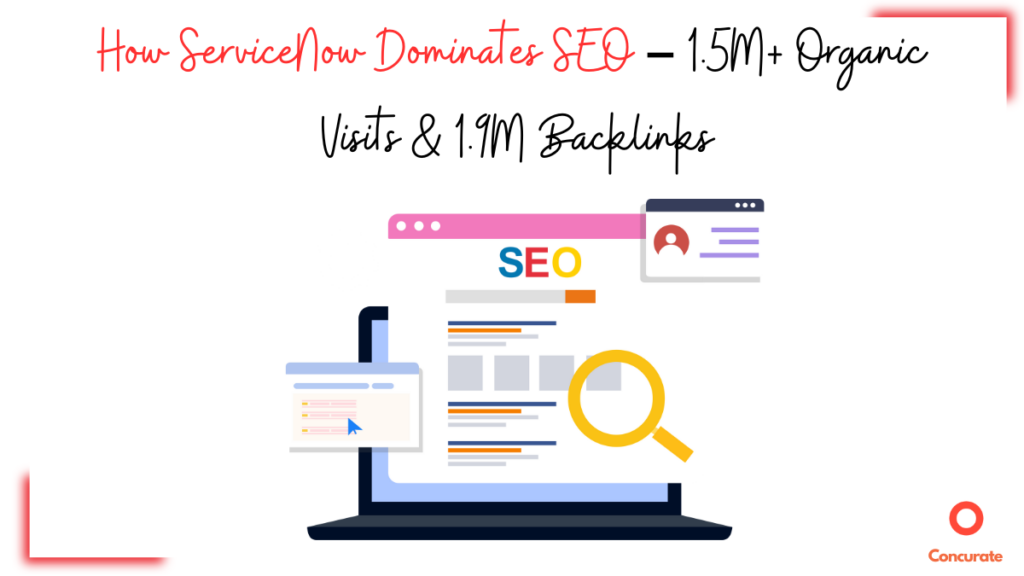Most SaaS brands obsess over blog output.
ServiceNow? Instead of chasing volume, they’ve turned product and solution pages into traffic magnets.
No keyword stuffing. No link buying.
Just smart strategy mapped to how buyers actually search.
They’re scaling traffic on the back of ultra-lean, intent-rich pages like:
- “What is ITSM?” (2K volume)
- “What is IT Support?” (25K volume)
- “What is ITAM?” (3.7K volume)
These aren’t gated PDFs, trend forecasts, or 10x thought leadership. They’re glossary-style product explainers that quietly sit in high-value SERPs; and convert.
If you’re a SaaS founder, CMO, or CEO building in B2B tech, this teardown shows you:
● Why your product pages might be your biggest SEO moat (if you structure them right)
● How ServiceNow builds traffic machines from landing pages, not blog archives
● What makes their “what is…” strategy work at scale; without link-buying or keyword stuffing
ServiceNow’s SEO Power at a Glance
| Organic Traffic (Monthly) | 1.6M |
| Domain Rating (DR) | 85 |
| Backlinks | 1.9M |
Where ServiceNow’s Traffic Comes From
| Traffic Source | Monthly Visits | % of Total Traffic |
|---|---|---|
| Branded Searches | 1.2M | (Users familiar with the brand) |
| Non-Branded Searches | 389.5K | (Capturing new users) |
| Informational Searches | 1.4M | (Users looking for knowledge) |
| Navigational Searches | 882.3K | (Users searching for specific pages) |
| Commercial Searches | 968.6K | (Users researching before buying) |
Key Learning: ServiceNow balances branded dominance with high-value, non-branded content, ensuring it reaches audiences at different stages of the buying journey.
Top Pages Driving Traffic for ServiceNow
| Page URL | Top Keyword | Position | Traffic |
|---|---|---|---|
| https://www.servicenow.com/products/itsm/what-is-it-support.html | it support | 3 | 5,846 |
| https://www.servicenow.com/products/itsm/what-is-itsm.html | what is itsm / itsm | – | 1,742 |
| https://www.servicenow.com/products/field-service-management.html | field service management | 2 | 1,670 |
| https://www.servicenow.com/products/itsm/what-are-it-solutions.html | it solutions | 4 | 1,564 |
| https://www.servicenow.com/products/it-operations-management/what-is-cmdb.html | cmdb | 5 | 1,452 |
| https://www.servicenow.com/products/it-asset-management/what-is-itam.html | it asset management | 4 | 1,276 |
| https://www.servicenow.com/products/it-operations-management.html | itom | 2 | 1,133 |
| https://www.servicenow.com/products/it-asset-management/what-is-eula.html | eula | 5 | 1,132 |
Why These Pages Win
#1 The homepage is an SEO magnet, ranking #1 for “ServiceNow” globally.
#2 Regional pages dominate local searches, boosting international reach.
#3 Educational content ranks #1 for competitive industry terms, proving that informational SEO still drives major traffic.
ServiceNow Wins with Search Intent
#1 Brand-driven queries lead the way, as “ServiceNow” itself is the top-performing keyword across multiple regions.
#2 Certification demand surges, with the “Training and Certification” page ranking for high-intent searches like “ServiceNow certification.”
#3 IT solution seekers find answers, with the “What is ServiceNow?” page attracting professionals researching enterprise IT management.
ServiceNow’s Global SEO Reach
Traffic by Location
| Country | Monthly Visits | % of Total Traffic |
| United States | 643.3K | 40.2% |
| India | 333.4K | 20.8% |
| Japan | 72.4K | 4.5% |
| United Kingdom | 63.1K | 3.9% |
| Brazil | 55K | 3.4% |
Insights
#1 The United States is the dominant traffic source, driving over 40% of all visits.
#2 Japan’s traffic saw the biggest jump, increasing by 28.2K, signaling growing interest in the region.
ServiceNow’s Backlink Profile: The Authority Advantage
| Metric | Value |
| Total backlinks | 1.9M |
| Referring Domains | 18.3K |
| High-Authority Links | Links from Apple, Microsoft, Amazon, Wikepedia, Adobe |
Insights on ServiceNow’s Backlink Profile
#1 Backlinks from Apple, Microsoft, Amazon, Wikipedia, and Adobe signal trust and authority in the tech space.
#2 Massive Link Power: With 1.9M backlinks and 18.3K referring domains, ServiceNow dominates organic visibility, making it tough for competitors to outrank.
Traffic Breakdown
| Source | Value |
| Organic Search | 1.6M |
| Paid Search | 9K |
ServiceNow’s Paid Search Focus
Ads target both brand-related queries (“servicenow global”) and certification searches (“servicenow certified system administrator”), capturing professionals looking to upskill.
What They’re Bidding On
#1 “is servicenow a cm”
#2 “servicenow certified system administrator”
#3 “tech conferences”
#4 “servicenow global”
#5 “servicnow”
#6 “suppy chain 4.0”
#7 “servicenow las vegas 2024”
What Makes This Strategy Work?
Event & Industry Trends: Keywords like “tech conferences” and “ServiceNow Las Vegas 2024” show a push toward event marketing, while “supply chain 4.0” aligns with emerging industry innovations.
Top Strategies to Learn from ServiceNow’s Playbook
#1 Turn Definitions Into Dominance: ServiceNow’s Textbook SEO Power
ServiceNow ranks in the top 3–4 positions for ultra-competitive, high-volume keywords like “IT support” (25K) and “what is ITSM” (2K); with just two evergreen, 5K+ word pages. No fluff, no gimmicks; just well-executed SEO that keeps compounding.
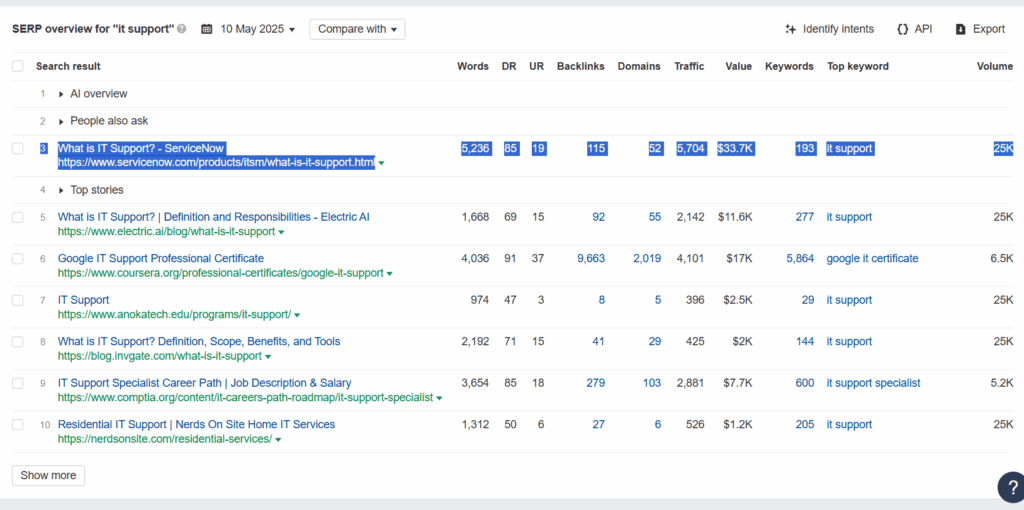
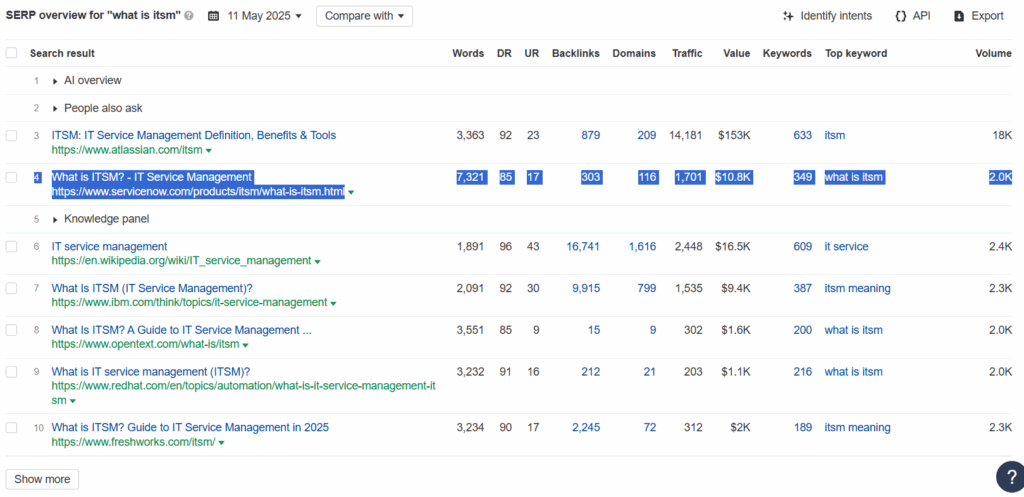
What ServiceNow Did Right:
- Crafted definition-style pillar pages that dominate high-intent, informational SERPs.
- Targeted evergreen queries that double as top-funnel education and product priming.
- Achieved strong rankings with 50–100 referring domains, not thousands—by aligning content deeply with searcher expectations.
SaaS Playbook: Things To Learn:
- You don’t need a blog calendar filled with thought leadership; just 2-3 timeless, well-structured guides can outperform.
- Own the narrative around core industry terms to become the go-to resource for first-touch discovery.
- Match search intent with absolute clarity; these pages answer the query head-on, then lead readers gently toward the product.
Example from SaaS:
HubSpot’s “What is CRM?” page ranks consistently on page one for years by following a similar approach: lead with education, then introduce the product as a natural solution. Learn from their SEO strategy.
Takeaway:
If you’re building a SaaS content strategy, don’t underestimate the compounding power of a few exceptionally executed, high-intent definition pages. ServiceNow proves that strategic depth beats shallow volume every time.
#2 Be the Buyer’s First Click: ServiceNow’s Intent-Aligned Product Pages
ServiceNow ranks #2 for “field service management” (3.2K) and #4 for “IT solutions” (5.1K) using clean, product-aligned landing pages that look nothing like traditional blogs. Each page sits at the intersection of high commercial intent and search volume, funneling organic traffic directly into product context.
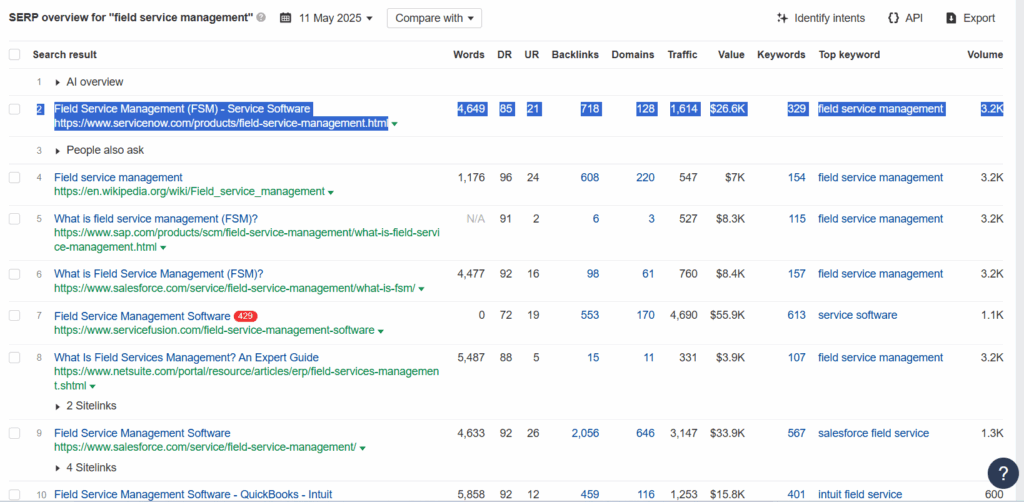

Example from SaaS:
ClickUp’s “project management” page ranks for high-volume terms by doing exactly this: weaving product relevance into SEO-rich copy without losing clarity or conversion focus. Learn from their top strategies.
What ServiceNow Did Right:
- Turned product pages into ranking assets, not just sales destinations.
- Embedded SEO-driven education directly within sales pages; no separate blog needed.
- Outranked many publishers with under 130 referring domains, thanks to relevance and page structure.
SaaS Playbook: Things To Learn:
- Blend product + search intent; when someone Googles “field service management,” they’re ready to explore a solution, not just definitions.
- Use modular content; benefits, features, use cases, FAQs; all SEO-rich and scannable.
- Don’t silo SEO to your blog. Make your product pages do the ranking.
Takeaway:
If you’re a SaaS founder or CMO, remember this: you don’t need a separate content playbook for SEO and product.
Pages that answer high-intent queries and lead directly to your solution can do both jobs; brilliantly. ServiceNow’s playbook shows how to turn traffic into trials without detouring through a blog.
#3 Turn Definitions into Demand: How ServiceNow Converts Explainers into Product Traffic
ServiceNow ranks #4 for “IT Asset Management (3.7K)” and #4 for “ITOM (2.4K)” with product subpages masquerading as helpful explainers. These aren’t fluff-filled blogs—they’re lean, high-ranking conversion pages built around deeply commercial terms.
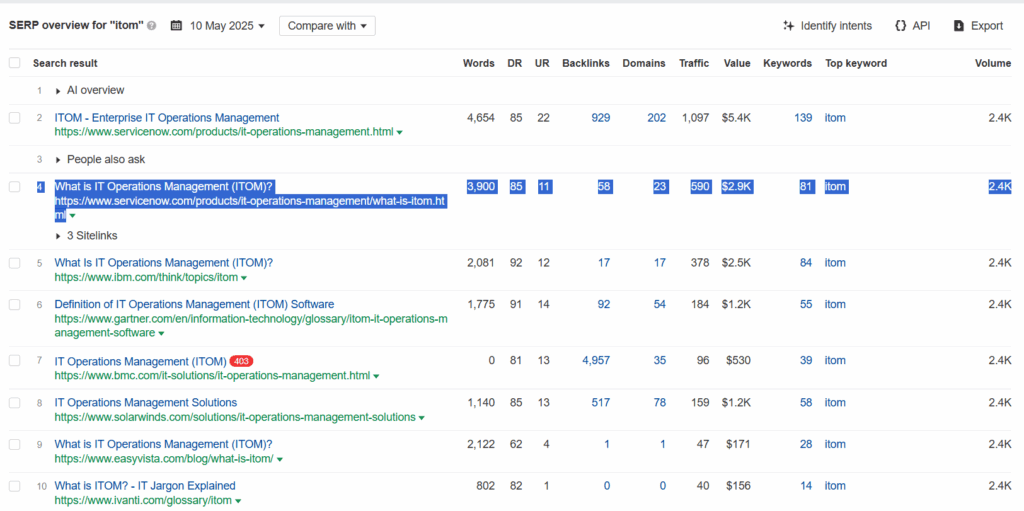
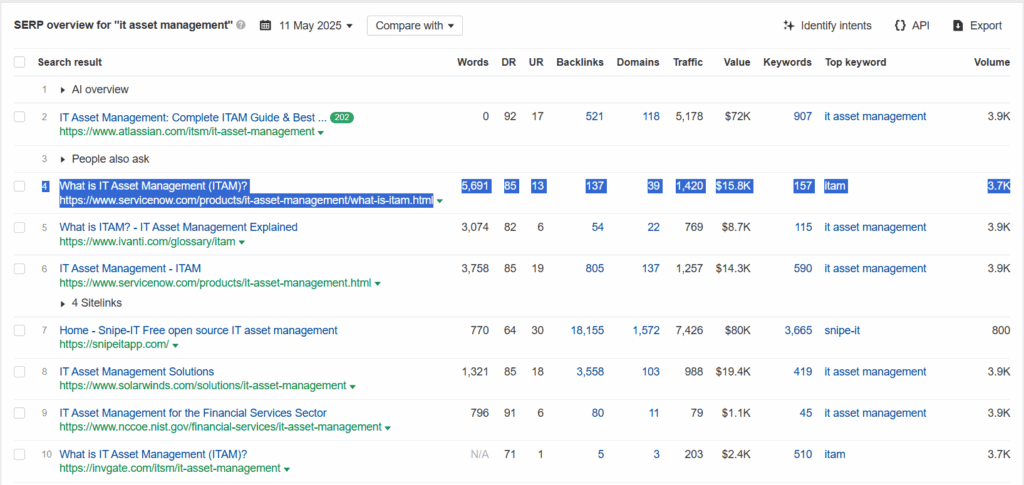
What ServiceNow Did Right:
- Used definition-style H1s (“What is ITAM?” / “What is ITOM?”) to grab top-of-funnel search intent.
- Wrapped the “what” with the “why us”‘; leading directly into product positioning without hard selling.
- Dominated competitive SERPs with sub-100 referring domains, using precision content architecture over brute force.
SaaS Playbook: Things To Learn:
- Lead with clarity: Help users understand the term before pitching the tool. Trust follows transparency.
- SEO ≠ blog: Glossary-style pages tied to actual product features can outperform top content hubs.
- Optimise for both readers & revenue: Each scroll answers a question and nudges toward the CTA.
Takeaway:
Don’t sleep on glossary pages. If you’re in SaaS, these aren’t just SEO “add-ons”; they’re acquisition engines. ServiceNow turns abstract IT jargon into product-qualified traffic by anchoring high-intent definitions directly to their solutions.
Ready to Own Your Industry’s SERP?
At Concurate, we help SaaS and POS brands create SEO strategies that capture high-intent search and establish real market leadership.
We specialize in building content that ranks for what buyers are actually searching for, educates technical and operational audiences, and drives qualified leads.
Our approach helps you:
● Secure visibility across bottom-funnel, solution-aware, and competitor searches
● Build trust with technical, compliance, and business buyers
● Turn organic search from a cost center into a pipeline driver
If you are ready to create SEO assets that dominate buying moments and accelerate your growth, we are ready to help. Book a strategy consultation with Concurate today.
Disclaimer:
This article is an independent analysis based on publicly available data regarding ServiceNow’s SEO strategy. It is not endorsed by, affiliated with, or sponsored by ServiceNow Inc. All trademarks mentioned are the property of their respective owners.


